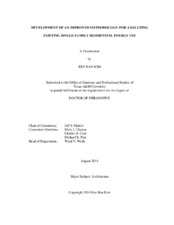Development of an Improved Methodology for Analyzing Existing Single-Family Residential Energy Use
Abstract
The purpose of this study was to develop an improved methodology for analyzing the energy use from existing single-family. The overall goal of this work is to make home energy audits more effective by providing homeowners and energy auditors with an improved and reliable tool to identify over-consumption in a residence by showing where the energy is inefficiently being used in the residence when compared to buildings of similar size in similar climates. Such a tool can be used by auditors to quickly assess the problems in the building, determine accurately what needs to be fixed and to provide useful guidance before arriving on-site. In order to accomplish this, an improved methodology for an easy-to-use, semi-automatic calibrated simulation that can determine potential energy conservation measures for single-family residences was developed and tested.
As a first step, an easy-to-use simulation which can be used by homeowners who are not familiar with residential building energy analysis was developed. Users of this easy-to-use simulation are only required to input basic information of their houses such as construction year, size and location of the house, with the other inputs for building energy simulation being filled-in automatically using a newly established statistical house information database for Texas. Next, the easy-to-use simulation is calibrated using the semi-automatic calibrated simulation methodology that matches the simulated and actual utility electricity and natural gas use of the house. In order to develop this methodology, a sensitivity analysis was performed using a three-parameter change-point
regression model that regresses the energy use against ambient temperature. The analysis showed the most significant simulation parameters that affect residential energy use that are decomposed into the baseload, the change-point temperature, and the cooling or heating slope. These parameters were used to calibrate each part of the building energy use against the actual monthly electricity and natural gas use.
In the next step, the calibrated simulation parameters were compared with similar input parameters of a standard house that is compliant with the 2009 IECC to determine the differences in the parameters and give guidance about what characteristics of the house were below the energy efficient characteristics of the 2009 IECC-compliant house. Using this comparison, the less energy-efficient parameters of the house were determined as potential energy conservation measures for a future retrofit, and finally, the most cost effective measures were determined through a simple pay-back cost analysis.
In order to verify the methodology, the both methods were tested on actual residence and the results were compared to determine if both procedures identified the same potential energy conservation measures. Once the procedure was demonstrated on the first case-study house, two additional houses were also tested to verify how well the procedure worked. The comparisons showed that the easy-to-use and the actual simulations resulted in the same potential energy conservation measures with the similar pay-back period, and thus was verified that the easy-to-use simulation can be used for a home energy audit procedure with reliability.
Subject
Existing Single-family Residential Energy UseHome Energy Audits
Easy-to-use Simulation
Calibrated Simulation
Energy Conservation Measures
Citation
Kim, Kee Han (2014). Development of an Improved Methodology for Analyzing Existing Single-Family Residential Energy Use. Doctoral dissertation, Texas A & M University. Available electronically from https : / /hdl .handle .net /1969 .1 /153252.


